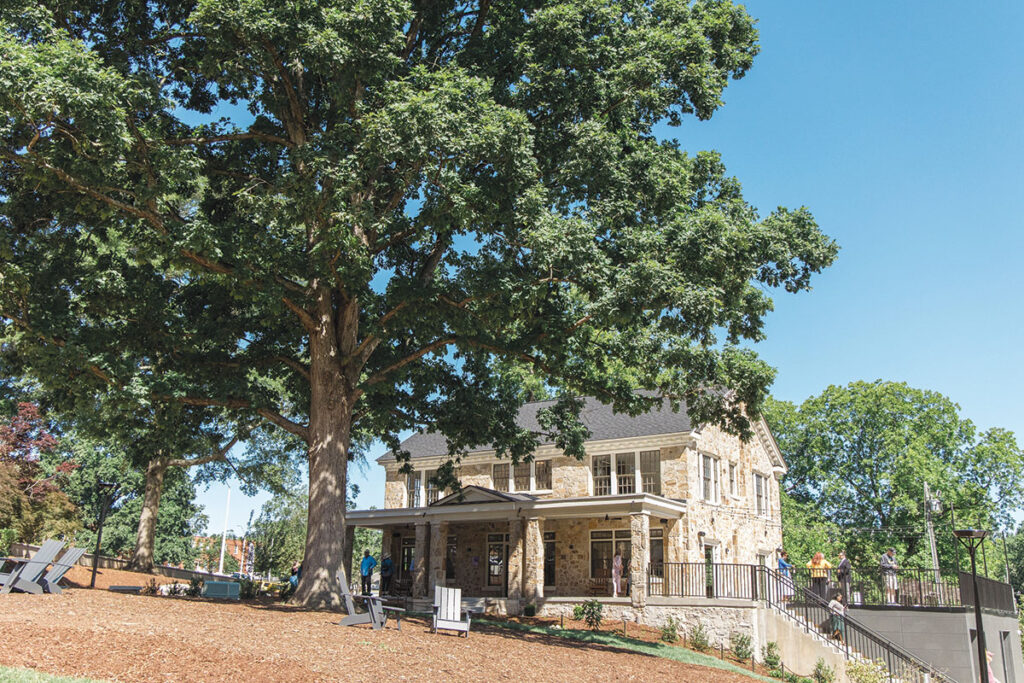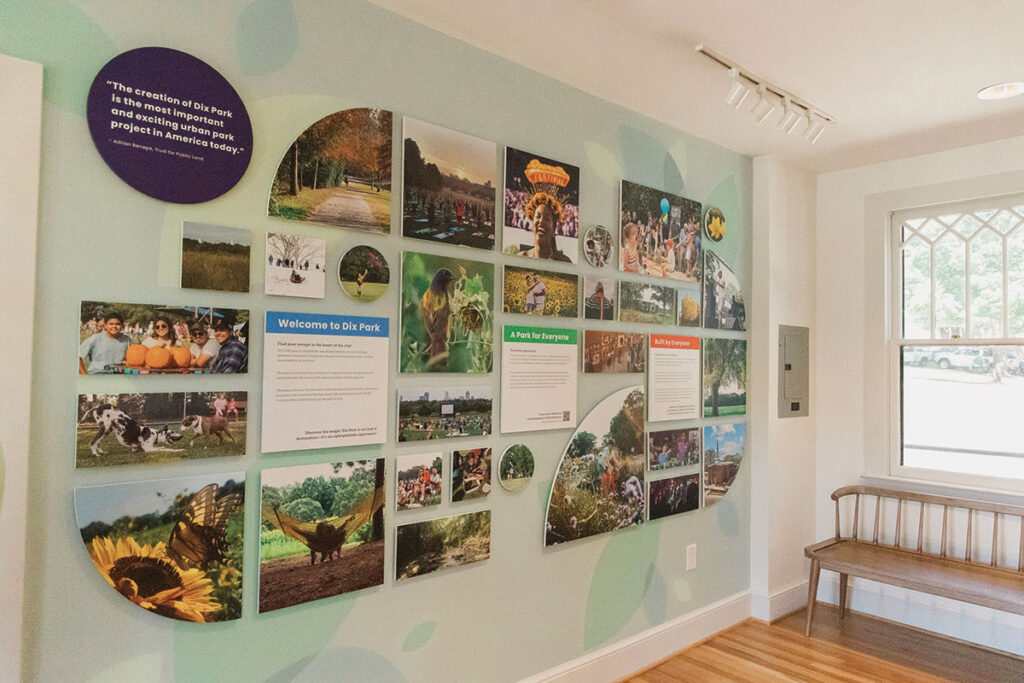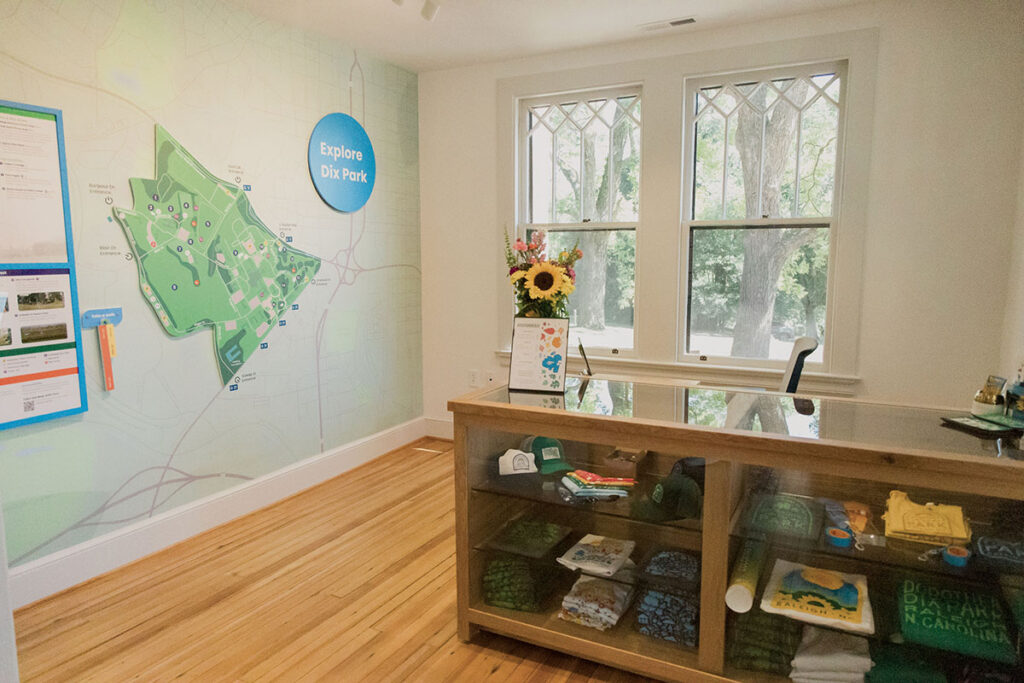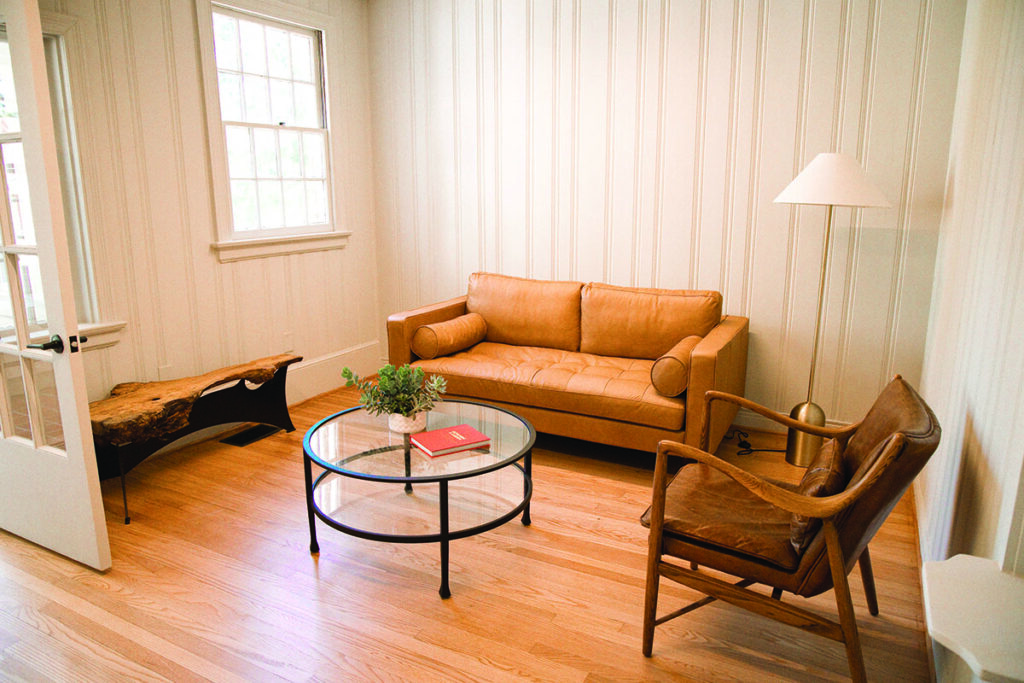Article:
PICTURED ABOVE: The Gatekeeper’s Cottage will function as Dorothea Dix Park’s first visitor’s center.
Dorothea Dix Park builds on its legacy to enhance its offerings and connect with the community.
BY KRISTEN SCHRUM | PHOTOS BY LEAH MARIE PHOTOGRAPHY UNLESS OTHERWISE NOTED
In 2017, the City of Raleigh, alongside Dix Park Conservancy, began an ambitious project to transform Dorothea Dix Park into a leading public park in the United States. This transformation, led by Michael Van Valkenburgh Associates, along with various consultants, undertook a massive engagement strategy that involved over 65,000 local residents.
On February 19, 2019, after extensive planning and community involvement, the Raleigh City Council officially adopted the Dorothea Dix Park Master Plan. This adoption was a significant milestone as it validated the community-driven plan and set the stage for the next phase of development. The plan, while focusing on seven major projects—including creating a vibrant plaza and play area that brings families together—involves breathing new life into the park’s historic stone houses, preserving the dignity of these structures and making them more accessible to the public.
These projects embody the three core principles of the park’s Master Plan: “Open Up and Connect, Build from What is There, and Offer Something for Everyone.” By connecting the park to the broader community, enhancing its unique landscapes and structures and creating diverse spaces for all users, these projects improve the park’s edges, establish new entry points and highlight the dual nature of the site as a tranquil natural retreat and vibrant urban park.


A Rich History
Long before its transformation into an urban park, Dorothea Dix Park was historically significant. It initially served as vital land for Indigenous peoples, including the Coharie, Cherokee, Haliwa-Saponi, Lumbee, Meherrin, Occaneechi, Sappony and Waccamaw Siouan. The land later became part of the Spring Hill plantation, where enslaved African Americans toiled for 150 years. Subsequently, the site became North Carolina’s first mental health facility, Dorothea Dix Hospital, which operated for over a century and briefly housed the state’s Department of Health and Human Services.
This rich and complex tapestry of human experiences led to the City of Raleigh’s decision to have Dix Park recognized as a member of the International Coalition of Sites of Conscience. This global network comprises historic sites and museums dedicated to making the past a dynamic part of the future, using history to inspire and foster social justice and human rights. “The history of this site is vast,” explains Anna Torres, senior communications and marketing manager at Dix Park Conservancy, “Dix has been historically significant for a long time, and we want to honor that.”
By 2015, Raleigh acquired the park, intending to balance its historical significance with new urban park developments. Dix Park Conservancy then appointed a Legacy Committee to ensure respectful homage to the site through a cultural interpretation plan, educating visitors and linking historical insights to contemporary local relevance.
“Part of our role is to educate future generations about what was here,” explains Torres, reflecting the Conservancy’s belief that understanding community priorities can guide structured recommendations for sharing the site’s history with visitors, linking the past to what matters to locals today.
Central to this mission are the park’s historic stone buildings—originally staff residences—now under renovation to preserve the park’s legacy while supporting its transformation.



Restoration and Renewal
The rehabilitation of the stone houses at Dorothea Dix Park blends historical preservation with modern functionality to reimagine these storied structures for public enjoyment and use. “We are excited that these buildings have a new future for the park,” declares Nick Smith, chief of staff for Dix Park Conservancy. “They are very special buildings that deserve to be honored in special ways.”
During renovation, architects and planners were asked to keep the original aesthetic and structural components of these houses, which were originally built in the 1920s for Dorothea Dix Hospital. The renovations preserve the original windows, locally quarried stone and authentic layouts while making updates that will meet accessibility and sustainability requirements. The Superintendent’s House, which remains on its original foundation, was once the hospital superintendent’s office space and the residence for the superintendent’s family. This building is now designated to become offices for Dix Park Conservancy, while an extended porch will offer panoramic views of downtown Raleigh. A new basement addition is planned to include public restrooms, enhancing visitor accessibility and convenience.
Originally the residence of the lead physician, the Physician’s House is being transformed into a vibrant community space. This house will accommodate various functions, including city staff volunteer services for the park, a conference room, an educational classroom, programs run by the Conservation Corps, and an innovative artisan residency program that the Conservancy hopes to introduce later on in the summer.
Lastly, the Gatekeeper’s Cottage, once situated at the park’s original entrance, is set to become Dorothea Dix’s first visitor center. It will provide a welcoming space for guests, complete with essential information such as visitor maps, an overview of ongoing projects in Dix Park and an exhibit dedicated to the history and legacy of the property.
The initiation of these renovations was a key priority in Phase 1 of the park’s Master Plan, made possible through a significant contribution from the SECU Foundation. This gift of $5 million was particularly poignant given the site’s history as a mental hospital where generations of state employees—including State Employees Credit Union staff—were supported by the hospital’s services.
“The foundation believed this renovation struck the perfect balance between honoring the past and bringing the park into the next generation of users,” Smith explains, highlighting the deep connection between the park’s past and its future.
Smith further elaborates on the impact of this funding: “The SECU [Foundation] catalyzed the project and made it possible. We all wanted to make it more comfortable and attractive to be here in the park, because it’s a great opportunity for the community to gather.”
Thanks to these thoughtful renovations, the stone houses are poised to offer necessary amenities while preserving their historical essence, bridging the gap between past and present and ensuring that the legacy of those who once inhabited these buildings continues to enrich the community.



PICTURED ABOVE: The renovation of the stone houses included creating pleasant office and community spaces for Dix Park Conservancy workers, volunteers and others.
Sunnier Fields on the Horizon
The current transformation of Dix Park continues into the next exciting phase: the restoration of Rocky Branch Creek, which weaves together the enhancement of the park’s famous sunflower field.
The five-acre sunflower field at Dix Park represents a flourishing City of Raleigh partnership between Raleigh Water, the Raleigh Parks, Recreation and Cultural Resources department, and Raleigh’s Office of Sustainability. This initiative began with Raleigh Water preparing the field in spring and planting approximately 280,000 Hunters Select Peredovik sunflower seeds by mid-May. Raleigh Parks then takes on the responsibility of watering and maintaining the field as the sunflowers grow. They further enhance the area’s beauty and ecological health by planting wildflowers along the field’s perimeter.
The sunflower field has evolved into a vital pollinator habitat, supporting a diverse range of bees, butterflies and other wildlife. During peak bloom, this vibrant spectacle attracts over 100,000 visitors from both the local community and beyond, making it a significant draw for the park. Once the blooming season concludes, the sunflowers serve an additional ecological purpose by providing seeds for birds and other wildlife throughout the fall.
Building on this success, Dix Park is planning another expansive floral project set to launch in 2024. This project aims to further integrate the park’s natural beauty with its community engagement efforts, reinforcing Dix Park’s role as a key ecological and recreational hub in Raleigh. This future project promises to enhance the park’s landscape further and attract even more visitors, continuing to connect the community with nature and the park’s evolving story.

Rare Painted Bunting Spotted in Dix Park
For the past three years, Dix Park visitors have been treated to a rare avian sighting for the Raleigh area: the painted bunting. Known for its colorful plumage, the painted bunting typically favors coastal regions. Its consistent appearances in Raleigh have sparked excitement among bird enthusiasts and casual park-goers alike. So far, birders and ornithologists have observed the same male bunting returning to the park each year. Click here to learn more about the Dix Park painted bunting and where to find it in the park.
Share a photo of your adventure and you could win a prize! Check out @midtownmagazine on Instagram for details.



